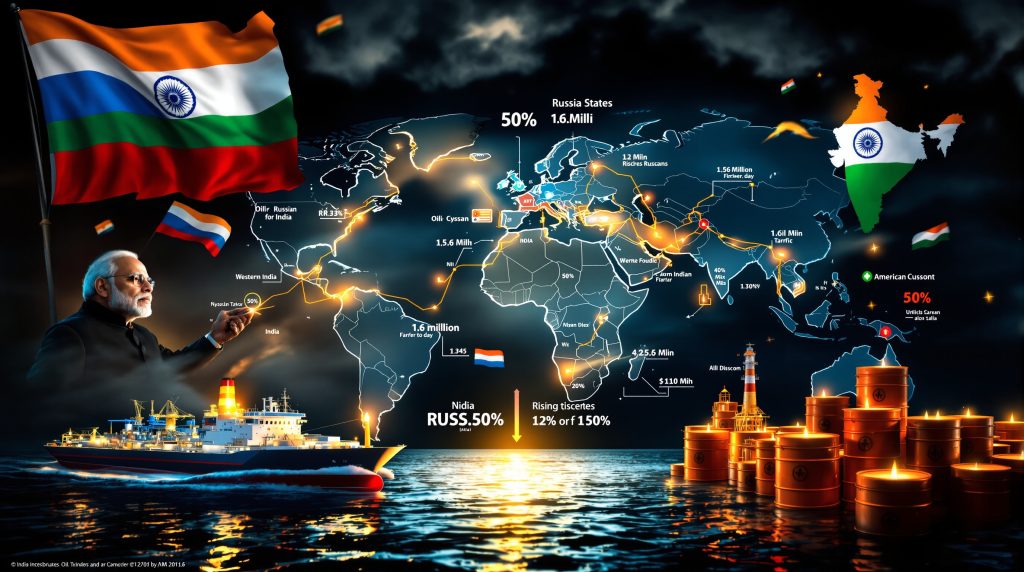The High-Stakes Geopolitical Energy Showdown
The potential disruption of Russian oil flows to India represents one of the most consequential energy geopolitical developments of 2025. As the United States imposes escalating tariffs on Indian exports—reaching a punitive 50% rate—to pressure New Delhi into reducing Russian crude purchases, the implications extend far beyond bilateral trade relations. This high-stakes standoff threatens to reshape global energy markets, alter strategic partnerships, and test the limits of economic sanctions as a foreign policy tool.
India, which imports approximately 85% of its oil needs, has dramatically increased its Russian crude purchases since 2022, with Russia emerging as its largest single supplier. The Trump administration's aggressive tariffs impact markets strategy aims to disrupt this arrangement, creating a complex web of economic, diplomatic, and energy security challenges that could reverberate throughout global markets.
Why Has India Become Russia's Largest Oil Customer?
The Dramatic Shift in India's Oil Import Strategy
Prior to 2022, Russian crude represented less than 2% of India's oil imports. Following Western sanctions on Russia after its invasion of Ukraine, this figure surged dramatically, with Russian oil now accounting for approximately 35-40% of India's total imports—around 1.6 million barrels per day. This transformation occurred for several compelling reasons:
-
Significant price discounts: Russian crude has typically traded $2.50-$3.00 below international benchmark prices, creating substantial savings for price-sensitive Indian refiners
-
Pragmatic energy security: India's rapidly growing economy requires affordable energy inputs to maintain economic growth
-
Strategic autonomy: India has historically maintained an independent foreign policy, resisting alignment with Western sanctions regimes
-
Initial Western acceptance: The Trump administration initially encouraged India's purchases as a way to keep Russian oil flowing while limiting Moscow's revenue
The Economic Logic Behind India's Russian Oil Purchases
India's decision to increase Russian oil imports has been driven by clear economic calculations. According to financial analysts, India has saved approximately $10-25 billion since 2022 through discounted Russian crude purchases. For a developing economy with significant energy needs, these savings represent meaningful economic advantages:
-
Reduced inflationary pressure on domestic fuel prices
-
Improved trade balance and foreign exchange conservation
-
Enhanced competitiveness for energy-intensive industries
-
Increased refining margins for both state-owned and private refiners
What Are the US Tariffs Trying to Accomplish?
The Escalating Pressure Campaign Against India
The Trump administration's tariff strategy represents a dramatic escalation in US efforts to isolate Russia economically. The timeline of this pressure campaign reveals its intensifying nature:
-
August 1, 2025: Initial 25% tariff imposed on Indian exports to the United States
-
August 6, 2025: Executive order signed adding another 25% tariff, bringing total to 50%
-
August 27, 2025: Full 50% tariff implementation scheduled to take effect
US Treasury officials have characterized India's continued Russian oil purchases as "profiteering" from the Ukraine conflict, arguing that India's energy relationship with Russia undermines broader sanctions efforts. The administration's stated objectives include:
-
Forcing India to significantly reduce or eliminate Russian oil imports
-
Demonstrating the economic costs of circumventing Western sanctions
-
Preventing Russia from using energy exports to finance its military operations
-
Establishing a precedent for pressuring other countries maintaining energy ties with Russia
The Broader Geopolitical Context
This tariff dispute occurs against a complex backdrop of shifting geopolitical alignments. The United States has cultivated India as a strategic partner in its Indo-Pacific strategy, particularly as a counterweight to China. However, the administration appears willing to risk this partnership to achieve its sanctions objectives against Russia.
The timing coincides with other significant developments:
-
Prime Minister Modi's planned visit to China for the Shanghai Cooperation Organization summit
-
Ongoing tensions between India and China along their disputed Himalayan border
-
Growing economic integration between Russia, India, and China outside Western financial systems
-
Increasing skepticism among developing nations about the effectiveness and fairness of Western sanctions
How Has India Responded to US Pressure?
India's Defiant Stance on Energy Sovereignty
India's response to US tariff pressure has been characterized by public defiance combined with subtle tactical adjustments. Prime Minister Modi has framed the issue as one of national sovereignty and economic self-interest, encouraging Indians to buy domestically produced goods while stating that "pressure on us may increase, but we will bear it."
India's diplomatic messaging has emphasized several key points:
-
Energy procurement decisions remain sovereign national choices
-
Western countries continue trading with Russia in various sectors while demanding India stop
-
The price differential between Russian and alternative crude sources represents an economic reality India cannot ignore
-
India's historical relationship with Russia predates the current conflict and spans multiple sectors
Tactical Adjustments Without Strategic Concessions
Despite this public defiance, Indian refiners have made modest adjustments to their purchasing patterns:
-
Slight reduction in Russian crude imports from approximately 1.8 million barrels per day to 1.4-1.6 million barrels per day
-
Increased purchases from alternative suppliers including the United States, Brazil, and Middle Eastern producers
-
Exploration of alternative payment mechanisms to reduce vulnerability to financial sanctions
-
Diversification of crude slates to maintain flexibility in sourcing decisions
Industry sources characterize these adjustments as "token gestures" rather than fundamental strategic shifts, suggesting India intends to maintain the core of its energy relationship with Russia while minimizing direct confrontation with the United States.
What Would Happen If India Stopped Buying Russian Oil?
Global Market Disruption Scenarios
The potential elimination of India's 1.6 million barrels per day of Russian crude purchases would create significant ripple effects throughout global oil markets. Energy analysts outline several possible scenarios:
Scenario 1: Supply Reduction and Price Spike
If Russian crude cannot find alternative buyers and effectively exits the market:
-
Global oil prices could increase by 10-15% due to tightened supply
-
Brent crude could potentially reach $75-80 per barrel
-
Inflationary pressure would increase in oil-importing economies
-
OPEC+ producers might benefit from higher prices while maintaining production discipline
Scenario 2: Redistribution to Alternative Buyers
If Russian crude finds alternative destinations despite sanctions:
-
China might increase its imports, though energy market analysts note limitations in Chinese refining capacity for additional Russian grades
-
Smaller Asian buyers could absorb some volume at even deeper discounts
-
"Dark fleet" tankers might facilitate continued flows outside traditional tracking systems
-
Russia would likely accept even lower prices, potentially reducing its energy export revenues
Economic Impact on India
For India, completely cutting off Russian oil for India would create substantial economic challenges:
-
State Bank of India research suggests India's fuel bill would increase by approximately $9 billion in FY26 and $11.7 billion in FY27
-
Refiners would need to reconfigure operations to process different crude slates
-
Transportation costs would increase as India sources from more distant suppliers
-
Domestic fuel prices might rise, creating inflationary pressure and potential political challenges
How Are Global Energy Markets Adapting to the Uncertainty?
Market Reactions and Price Movements
The uncertainty surrounding India's Russian oil purchases has created volatility in global energy markets:
-
Oil futures have demonstrated increased sensitivity to news about US-China trade tensions
-
The Brent-Dubai price spread has narrowed to unusual levels, reflecting changing trade flows
-
Freight rates for tankers on routes from Russia to Asia have fluctuated significantly
-
Trading houses have adjusted risk premiums on deals involving Russian crude
Refining Industry Adjustments
The global refining industry has begun adapting to potential disruptions:
-
Indian refiners are testing alternative crude slates to determine optimal processing configurations
-
Middle Eastern producers are adjusting their official selling prices to remain competitive
-
European refiners are preparing for potential redirected flows if Russian exports to India decline
-
US refiners are positioning to increase exports to India as alternative supply sources
What Are India's Alternative Supply Options?
Diversification Strategies and Challenges
If forced to reduce Russian imports, India would need to rapidly diversify its crude sources. Potential alternatives include:
Middle Eastern Suppliers
-
Traditional suppliers like Iraq, Saudi Arabia, and UAE could increase volumes
-
Challenges include higher prices, production constraints, and competition from other Asian buyers
-
Existing term contracts would need renegotiation to accommodate higher volumes
Atlantic Basin Sources
-
US crude exports to India increased 51% in the first half of 2025 compared to the previous year
-
Brazilian and Canadian producers offer potential alternative heavy and medium grades
-
Logistical challenges include longer shipping distances and higher transportation costs
African Producers
-
Nigeria, Angola, and Libya could provide alternative medium and light grades
-
Political instability in some producing regions creates supply reliability concerns
-
Quality differences would require refining process adjustments
Technical and Logistical Constraints
The technical feasibility of replacing Russian crude presents several challenges:
-
Indian refineries are optimized for specific crude slates, with some configured to efficiently process Russian Urals
-
Rapid switching between crude types can reduce refining efficiency and yield
-
Transportation infrastructure and shipping capacity limitations could constrain rapid diversification
-
Payment mechanisms and credit arrangements would need restructuring
What Are the Broader Geopolitical Implications?
Reshaping Strategic Partnerships
The US-India confrontation over Russian oil has created ripple effects throughout the international system:
-
Quad Alliance Tensions: The Quadrilateral Security Dialogue (US, India, Australia, Japan) faces internal strains as India reconsiders its alignment with US strategic objectives
-
Russia-India-China Triangle: Prime Minister Modi's attendance at the Shanghai Cooperation Organization summit in China signals potential closer coordination among these powers
-
Middle East Positioning: Gulf producers face competing pressures to maintain relationships with both India and Western allies
-
Global South Solidarity: Many developing nations view India's stance as a defense of economic sovereignty against Western pressure
Sanctions Effectiveness and Economic Coercion
The crisis raises fundamental questions about the effectiveness of economic sanctions and coercive trade measures:
-
If India maintains its Russian oil purchases despite significant economic costs, it demonstrates the limits of economic pressure
-
Alternative payment mechanisms and trade arrangements developed during this crisis could create lasting infrastructure for sanctions evasion
-
The willingness of the US to impose US economy tariffs on strategic partners may influence how other nations calculate their compliance with future sanctions regimes
How Might This Crisis Be Resolved?
Potential Compromise Scenarios
Several potential pathways could emerge to resolve the current impasse:
Scenario 1: Gradual Reduction Agreement
-
India agrees to a phased reduction in Russian oil purchases over an extended timeframe
-
The US provides compensatory benefits through increased energy cooperation and investment
-
Both sides claim diplomatic victory while preserving core interests
Scenario 2: Price Cap Compliance
-
India maintains Russian oil purchases but adheres more strictly to the G7 price cap mechanism
-
Enhanced transparency in pricing and payment mechanisms satisfies US concerns about sanctions evasion
-
Technical adjustments rather than volume reductions become the focus of negotiations
Scenario 3: Continued Standoff with Market Adaptation
-
India absorbs the economic costs of US tariffs while maintaining Russian oil purchases
-
Global markets adapt to the new reality through oil price movements and trade flow reconfiguration
-
The issue becomes normalized as part of broader US-India strategic competition
Long-Term Structural Changes
Regardless of the immediate resolution, this crisis will likely accelerate several structural changes in global energy markets:
-
Accelerated development of alternative payment systems outside Western financial infrastructure
-
Increased emphasis on energy security through supply diversification among major importers
-
Growing bifurcation between Western-aligned and non-Western energy trade networks
-
Reassessment of the effectiveness of energy sanctions as a foreign policy tool
A Watershed Moment for Energy Geopolitics
The US-India confrontation over Russian oil purchases represents a watershed moment in energy geopolitics with implications extending far beyond bilateral relations. The outcome will influence global energy markets, the effectiveness of economic sanctions, and the broader architecture of international cooperation.
For India, the crisis presents a fundamental test of its strategic autonomy and economic sovereignty. For the United States, it reveals the inherent tensions between competing foreign policy objectives—isolating Russia while maintaining strategic partnerships with key Indo-Pacific allies. For global energy markets, it demonstrates the resilience and adaptability of trade flows in the face of political pressures.
As this high-stakes standoff continues to unfold, its resolution—or lack thereof—will shape energy geopolitics for years to come, potentially accelerating the fragmentation of the global energy system into competing blocs with different rules, norms, and strategic alignments. Concerns about US oil production decline add further complexity to this already challenging situation.
FAQ: Key Questions About India's Russian Oil Purchases
How much Russian oil does India currently import?
India imports approximately 1.6 million barrels per day of Russian crude oil, representing roughly 35-40% of its total oil imports. This volume has increased dramatically from less than 2% before 2022.
Why did the Biden administration initially support India buying Russian oil?
The Biden administration initially viewed India's increased Russian oil purchases as a mechanism to keep global oil prices stable while still applying economic pressure on Moscow through reduced revenues. Treasury Secretary Janet Yellen stated in 2022 that "Russian oil is going to be selling at bargain prices and we're happy to have India get that bargain."
What alternative suppliers could replace Russian oil for India?
India's main alternatives include traditional Middle Eastern suppliers (Iraq, Saudi Arabia, UAE), Atlantic Basin sources (United States, Brazil, Canada), and African producers (Nigeria, Angola). Each alternative presents different pricing, quality, and logistical considerations.
How would global oil prices be affected if India stopped buying Russian oil?
Energy analysts suggest that if 1.6 million barrels per day of Russian crude effectively exited the market, global oil prices could increase by 10-15%. The actual impact would depend on whether alternative buyers emerged and how OPEC+ responded to the supply disruption.
What payment mechanisms does India use for Russian oil purchases?
India has developed alternative payment arrangements including rupee-ruble mechanisms, the use of third currencies like the UAE dirham, and vostro accounts that allow transactions outside the US dollar system. These mechanisms help insulate the trade from Western financial sanctions.
Further Exploration:
Readers interested in learning more about the geopolitical implications of cutting off Russian oil for India can also explore related educational content available at Oilprice.com, which offers regular analysis of international energy markets and trade relationships. For the latest developments on this ongoing situation, The Guardian provides comprehensive coverage of the political dimensions of this trade dispute.
Want to Stay Ahead of Major ASX Mining Discoveries?
Don't miss out on potential investment opportunities like those discussed in this article. Discovery Alert's proprietary Discovery IQ model delivers instant notifications when significant mineral discoveries are announced on the ASX, giving you a crucial market advantage. Explore historic returns from major discoveries at https://discoveryalert.com.au/discoveries/ and position yourself to capitalise on the next big find.




